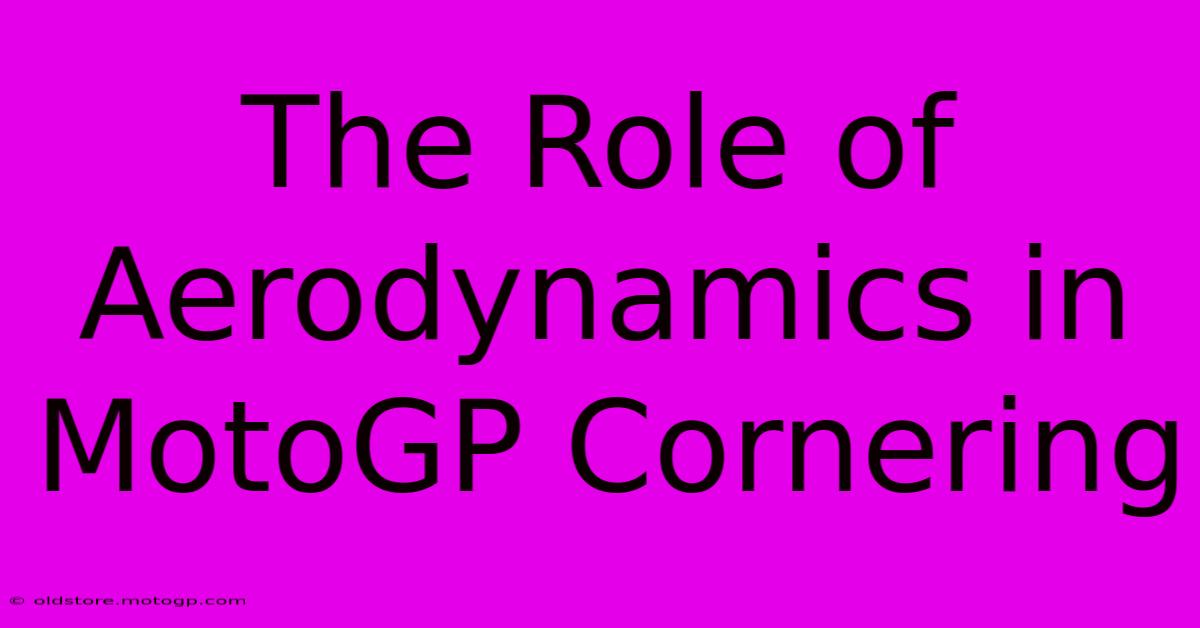The Role Of Aerodynamics In MotoGP Cornering

Table of Contents
The Role of Aerodynamics in MotoGP Cornering
MotoGP racing is a relentless battle for milliseconds, and every advantage counts. While rider skill and engine power are crucial, the often-overlooked science of aerodynamics plays a pivotal role, particularly in cornering. This article delves into how aerodynamic forces impact MotoGP bikes' ability to navigate turns at breathtaking speeds.
Understanding Aerodynamic Forces in MotoGP
MotoGP bikes aren't just fast in a straight line; they're designed to be incredibly stable and efficient through corners. This stability is significantly influenced by aerodynamic forces. Let's break down the key players:
1. Downforce: The Grip Generator
Downforce is the crucial aerodynamic force pushing the bike towards the track surface. Generated by carefully designed aerodynamic components like winglets, fairings, and the underbody, downforce increases grip, allowing riders to lean further into corners at higher speeds without losing control. More downforce translates to more traction, enabling later braking points and faster corner exits.
2. Drag: The Speed Limiter (But Not Always!)
While drag is generally seen as a negative force, resisting forward motion, it's not entirely detrimental in cornering. At high speeds on straights, drag slows the bike down. However, in corners, the relationship becomes more nuanced. A carefully managed level of drag can help stabilize the bike and prevent it from becoming too unstable when leaned over. It's a delicate balance – too much drag hinders speed, too little can lead to instability.
3. Lift: The Unwanted Force
Lift, the upward force that opposes downforce, is the enemy in cornering. It reduces grip and makes the bike more prone to high-siding, a dangerous loss of traction. Sophisticated aerodynamic designs aim to minimize lift, ensuring the bike remains planted on the track even at extreme lean angles.
Aerodynamic Components and Their Impact
The pursuit of optimal downforce and minimal lift has led to the development of several key aerodynamic components:
1. Winglets: The Mini-Wings
Winglets, those small wings protruding from the front fairing, are perhaps the most visible aerodynamic feature. They generate significant downforce at higher speeds, providing exceptional stability and allowing for later braking. The design and placement of winglets are constantly evolving, as teams strive for optimal performance.
2. Fairings: The Sculpted Shells
The bike's fairing is more than just a shell; it's an integral part of the aerodynamic package. Its shape and design are meticulously engineered to channel airflow, minimize drag, and maximize downforce. Teams experiment with different fairing designs to suit specific track characteristics and weather conditions.
3. Underbody: The Hidden Aerodynamic Advantage
The underbody of the bike is crucial for generating downforce. Smooth surfaces and carefully designed tunnels help manage airflow, creating a low-pressure zone beneath the bike that increases downforce. This hidden aspect of aerodynamic design is crucial for overall stability and performance.
The Constant Evolution of Aerodynamics in MotoGP
Aerodynamics in MotoGP is a constantly evolving field. Teams employ sophisticated computational fluid dynamics (CFD) simulations and wind tunnel testing to refine their designs. Regulations often change, leading to innovative solutions and a continuous arms race for aerodynamic advantage. The pursuit of that extra bit of downforce or reduced drag is an ongoing challenge that directly influences the outcome of each race.
Conclusion: Aerodynamics – A Cornerstone of MotoGP Success
Aerodynamics is not just a supporting factor in MotoGP cornering; it's a critical element determining a rider's ability to push the limits. The complex interplay of downforce, drag, and lift, shaped by meticulously designed components, allows riders to navigate corners at unbelievable speeds with precision and control. The constant evolution of aerodynamic technology underlines its importance in this high-stakes world of motorsport. The quest for the perfect balance continues, and the outcome of each race is often decided by the smallest of margins, often determined by aerodynamic superiority.

Thank you for visiting our website wich cover about The Role Of Aerodynamics In MotoGP Cornering. We hope the information provided has been useful to you. Feel free to contact us if you have any questions or need further assistance. See you next time and dont miss to bookmark.
Featured Posts
-
Moto Gp Arcade Game Get Ready For The Ride Of A Lifetime
Feb 19, 2025
-
Checkered Flag Fever Any Racing On Tv Today
Feb 19, 2025
-
The Science Behind The Speed Tnt Moto Gp
Feb 19, 2025
-
The Art Of Speed Celebrating The Best Moto Gp Riders
Feb 19, 2025
-
Experience The Grand Prix Austin F1 Transportation Solutions
Feb 19, 2025
